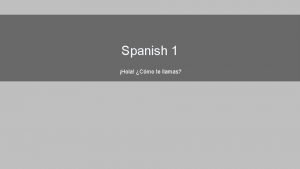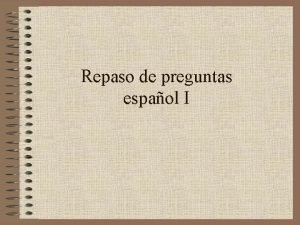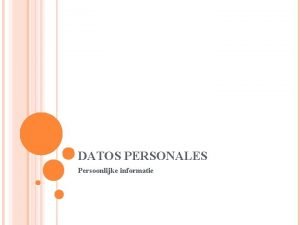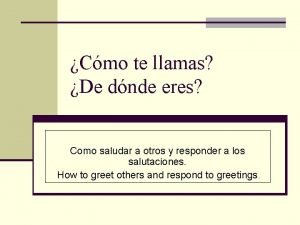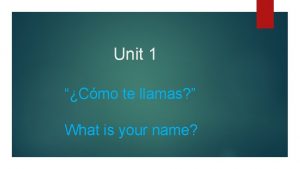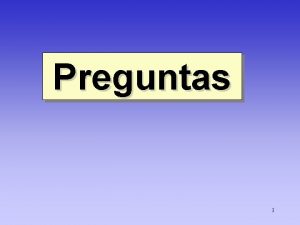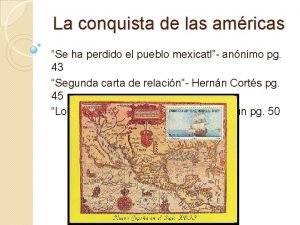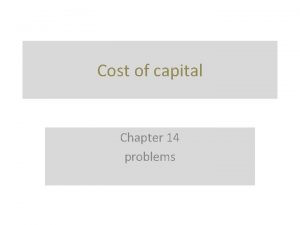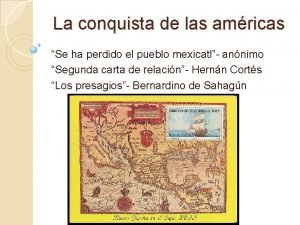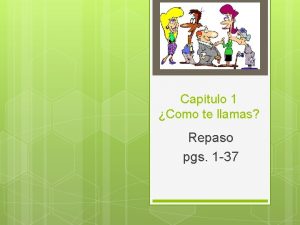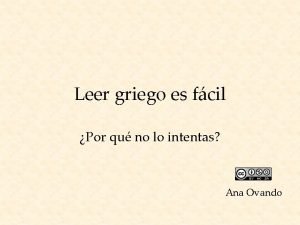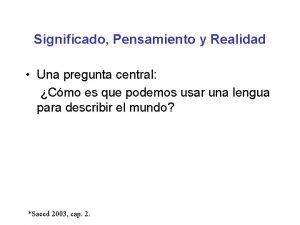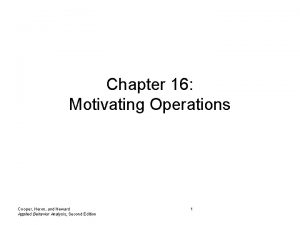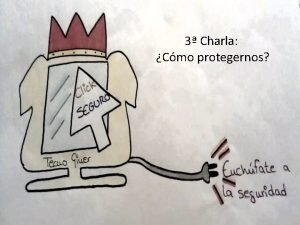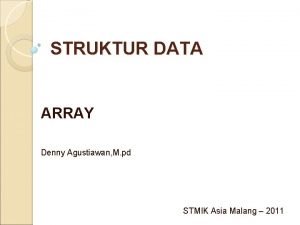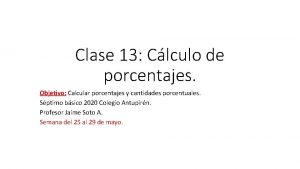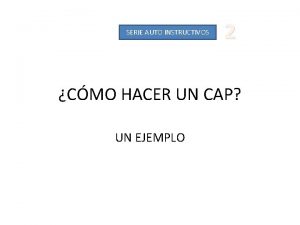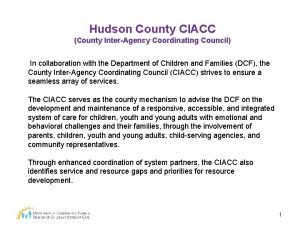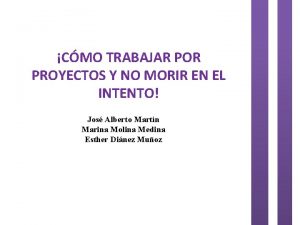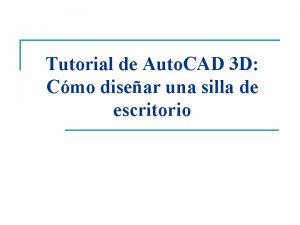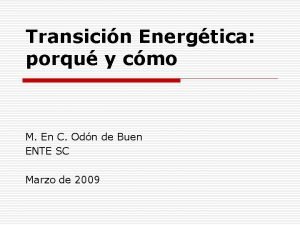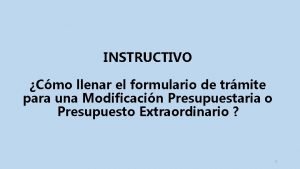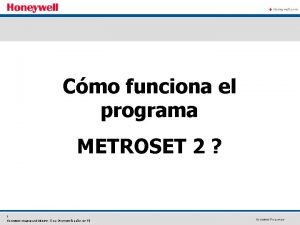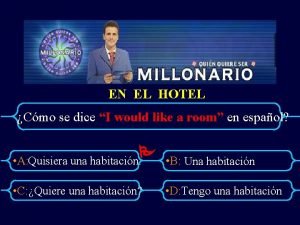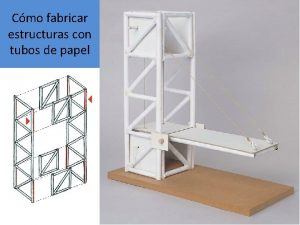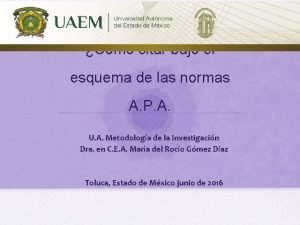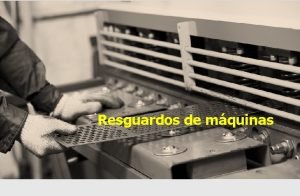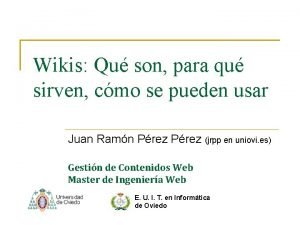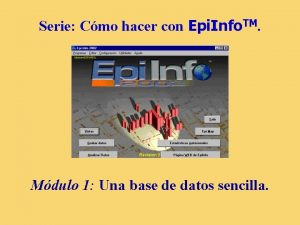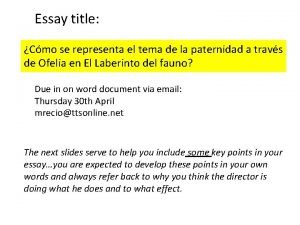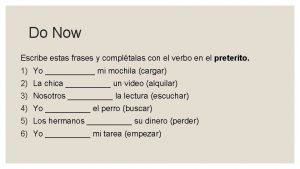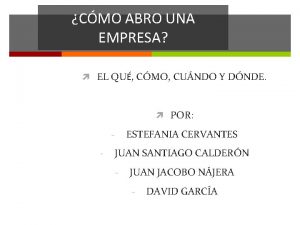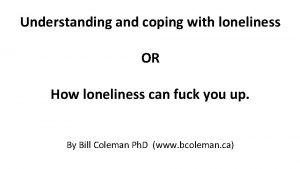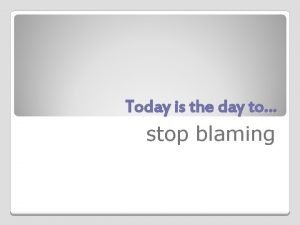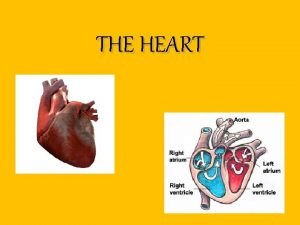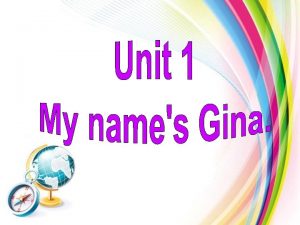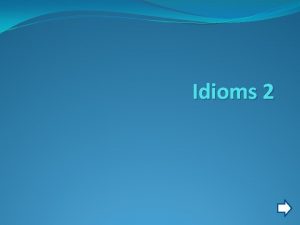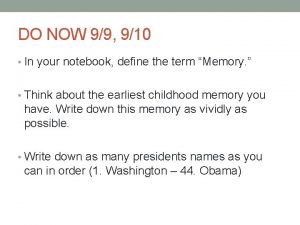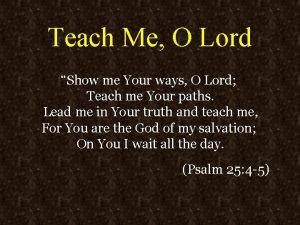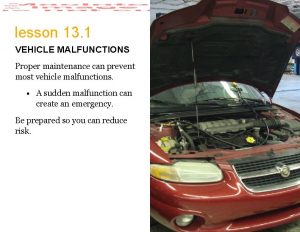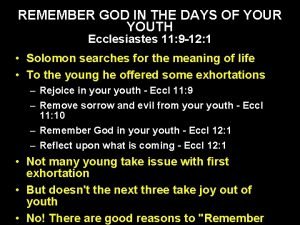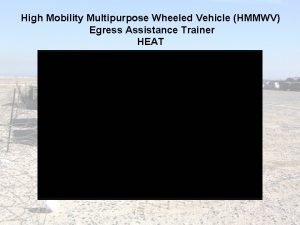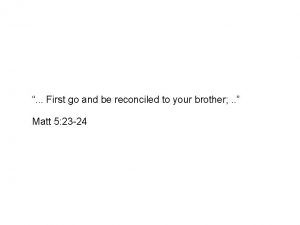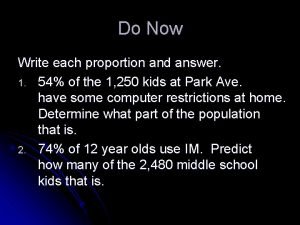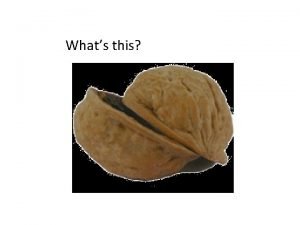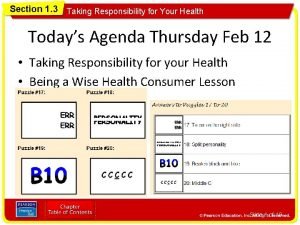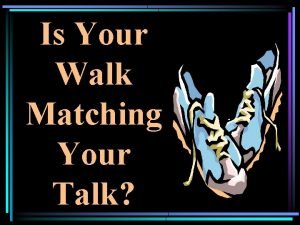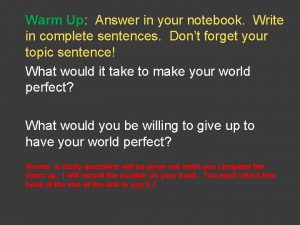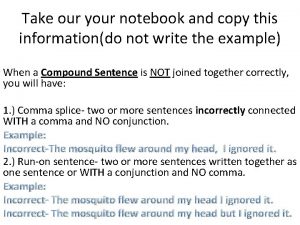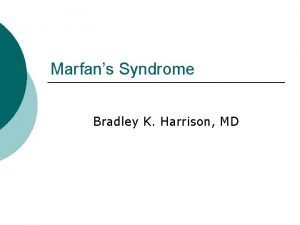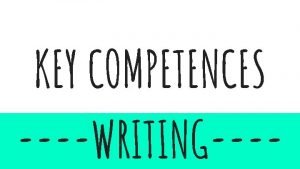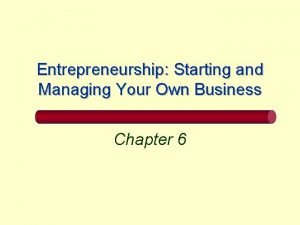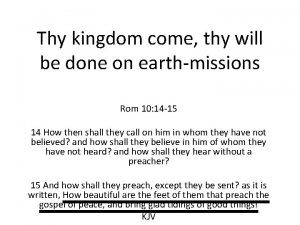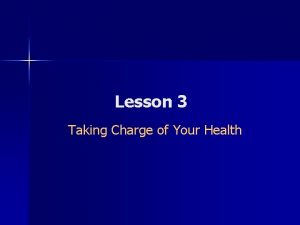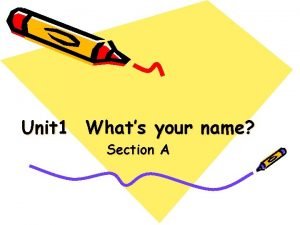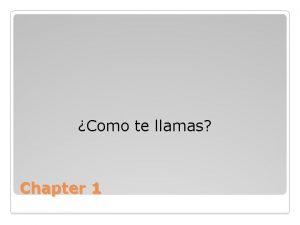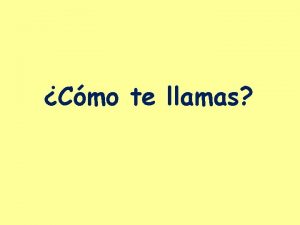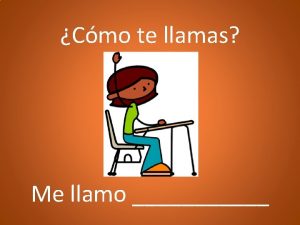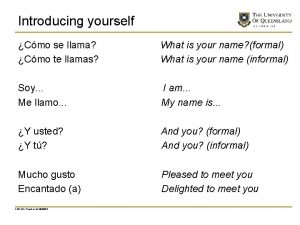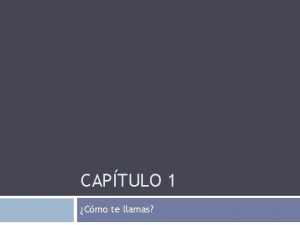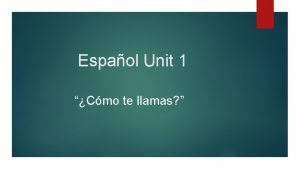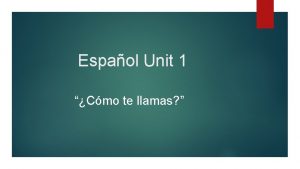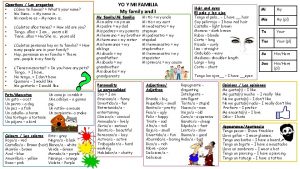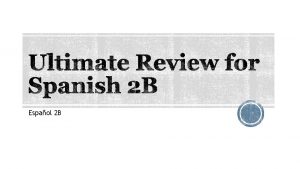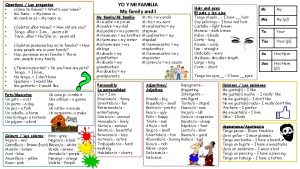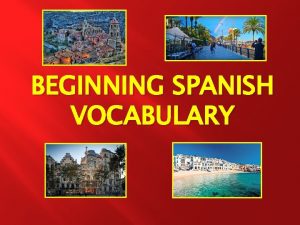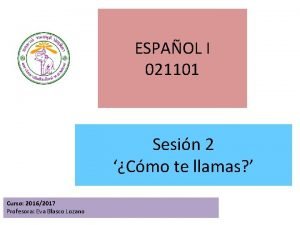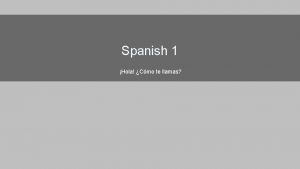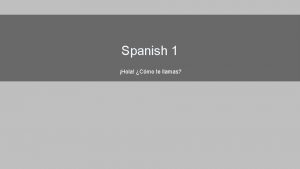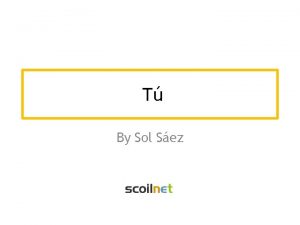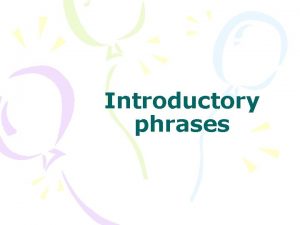Unit 1 Cmo te llamas What is your





































































































- Slides: 101

Unit 1 “¿Cómo te llamas? ” What is your name?

Levántate si te gusta… (Stand up if you like…) el helado

Levántate si te gusta… el fútbol

Levántate si te gusta… tocar la guitarra

Levántate si te gusta… el otoño

Levántate si tú tienes… (Stand up if you have…) un perro

Levántate si tú tienes… ojos azules

Levántate si tú tienes… un hermano

Levántate si tú tienes… una mochila rosada

Levántate si eres… (Stand up if you are…) de los Estados Unidos

Levántate si eres… artístico/a

Levántate si eres… muy alto/a muy=very

Levántate si eres… tímido/a

MATAmoscas

Frases útiles y mandatos- useful phrases and commands All commands are in the plural “ustedes” form (talking to more than one person) Be aware that the form changes when talking to one person “tú” form

ojos y orejas repitan miren trabajen en equipos escuchen trabajen con un compañero silencio paren levántense siéntense

estudien lean la frase cuenten las respuestas vengan recojan sus cosas tomen apuntes recuerden formen una cola escriban la palabra más fuerte

pasen los papeles entreguen la tarea completen el trabajo de timbre/el papel de salida abran/cierren la puerta hablen esperen levanten las manos contesten la pregunta saquen su carpeta ¿Preguntas? hay un examen ¿Terminado?

¿Voluntarios? ¿ ¿Ayuda? Necesito ¿Qué signfica un lápiz ____? ¿Cómo se dice ____? ¿Entienden? ¿Puedo ir al baño? No entiendo ¿Puedo tomar agua? No sé ¿Dónde está ___?

Bell work (Practice #3) 1. What is the difference between “trabajen en equipos” and “trabajen compañeros”? (Hint- the word “equipo” is on seat 3 A’s desk) 2. What does “Entreguen su tarea” mean? (Hint- it’s one of the first things you have to do when you arrive to class) 3. “Levanta la mano, por favor” is something I might say if you begin speaking out without permission. (Hint- la mano is a body part)

Trabajo de Timbre Práctica #3 1. Take notes = A. Saquen su carpeta B. Tomen apuntes 2. Read the sentence= A. Lean la frase 3. Share your answers= B. Escriban la palabra A. Contesta la pregunta B. Entreguen la tarea respuestas C. más fuerte C. formen una cola C. Cuenten las

El papel de salida Práctice #3 1. ¿Qué significa? 2. ¿Entienden? 3. ¿Puedo ir al baño? A. B C

Preguntas con compañero/a ¿Cómo te llamas? Interviewing kids in Panama ¿Cómo estás? https: //www. youtube. com/watch? v=DCZUHq. Vs. UQo ¿Cuántos años tienes? ¿De dόnde eres? ¿Cuál es tu color favorito? ¿Cuál es tu número (de télefono)? ¿Cuándo es tu cumpleaños? ¿Qué te gusta hacer? (trabajar, estudiar, cocinar)

El trabajo de timbre 1 (en español) 1. ¿Cuáles son 3 países (countries) hispanohablantes? 2. ¿Cuáles son 3 colores? 3. ¿Cuáles son 3 días (days) de la semana?

El papel de salida 1(en español) 1. ¿Cuál es tu color favorito? 2. ¿Qué día es hoy? 3. ¿Cuál es la diferencia entre hola y adiós?

Enfadado(a) Feliz Nervioso(a) Cansado(a) Aburrido(a) Emocionado(a) Irritado(a) Yo tengo hambre Triste tranquilo(a) Enfermo(a)




Más (more): -de nada -lo siento -mucho gusto -hasta luego -hasta mañana -hasta pronto -chao

Stand up, hand up pair up (Levántense, levanten las manos y emparejen) Diálogo 1 A. ¡Hola! B. ¡Buenos días! A. ¿Cómo te llamas? B. Me llamo _____. ¿Y tú? A. Me llamo _____. B. Mucho gusto. A. Igualmente. B. ¡Hasta luego! A. ¡Adiós! Diálogo 2 A. ¡Hola ______! B. ¿Qué tal? /¿Cómo estás? A. Bien, gracias. ¿Y tú? B. Muy cansado. A. ¡Hasta mañana! B. ¡Chao!


El trabajo de timbre 2 (en español) 1. ¿Cuál es la diferencia entre buenos días, buenas tardes y buenas noches? 2. ¿Qué significa “¿Cuántos años tienes? ”? 3. Contesten la pregunta…“¿Qué tal? ”

PAPEL DE SALIDA 2 1. 2. 3. X


Escriban lo que dicen. (Write what they are saying. )

¿Qué dicen?

Dibujen (draw) y crean una historieta

Matamoscas red January Wednesday 33 Go o mo d rnin g April Go Thank you Bye 11 March u o y e Se on so sorry He llo I am from… 6 bathroom Go 10 I don’t know 17 Okay (feeling) black 12 od on o n r fte od a 35 pink Monday 21 I need… please 18 ou y e Se r late white 13 eve nin g test you e Se orrow tom ’re u o Y me o c l we purple My name is… Homework/assignments fine yellow green bad Sunday

Los números- ball toss! 1 2 3 4 5 6 7 8 9 10 uno dos tres cuatro cinco seis siete ocho nueve diez 11 12 13 14 15 16 17 18 19 20 30 once doce trece catorce quince diez y seis diez y siete diez y ocho diez y nueve veinte treinta

Number links http: //www. quia. com/rr/116432. html Math practice 1 -20 http: //www. youtube. com/watch? v=3 Ox 8 o 8 Cb. P 9 c Number Rap 1 -100 Apple Bottom Jeans http: //www. abcya. com/counting_money. htm Money practice http: //www. youtube. com/watch? v=L 26 jwq. F 9 Zro Number 1 -30 Song and Macarena http: //childtopia. com/index. php? module=home&func=juguemos&juego=encuentra-200 -0001&newlang=spa Choose the number being said. http: //www. spanish. com/numbers/monster. html Feed the monster the number being said.

Number sequencing (what number comes next? ) Fill in the blanks 1. veinte y tres, veinte y cuatro, _____, veinte y seis 2. cuarenta y siete, cuarenta y ocho, cuarenta y nueve, _____ 3. _____, doce, trece, catorce, quince 4. treinta y dos, _____, treinta y cuatro, treinta y cinco 5. diez y seis, diez y siete, _____, diez y nueve

Ejercicios: Lean el número y escribanlo. 1. veinte y dos 2. doce 3. diez y nueve 4. cinco 5. quince

Las matemáticas Lean y contesten cada pregunta: 1. Veinte y cinco por (x) cuatro son_____. 2. Treinta y seis divido por (/)tres son_______. 3. Sesenta y cinco menos (-)quince son_____. 4. Cuarenta y ocho y (+)setenta y dos son_____. 5. Cien por (x) cero son_______.

El trabjao de timbre 3 (en espñol) Contesten las preguntas (con frases completas): 1. ¿Cómo te llamas? 2. ¿De dόnde eres? 3. ¿Cuántos años tienes?

El papel de salida 3 Escriban la letra correcta para cada número. 12 2. 30 3. 7 1. A. treinta B. siete C. doce

El trabajo de timbre 4 Lean el número y escribanlo. veinte y cuatro 2. once 3. diez y ocho 1.

El papel de salida 4 Escuchen los números y escribanlos. 1. 2. 3.

Matamoscas 6 1 19 15 30 12 9 5 14 10 7 8 20 3 16 11 13 2 18 25 4 17

¿Cuántos años tienen? La edad (age) Él tiene ______ años. Ella tiene ______ años.

Ellos tienen ______ años. Él tiene ______ años. Ella tiene ______ años.

later

La Edad- Age 1. 2. 3. 4. 5. ¿Cuántos años tiene tu madre? ¿Tu padre? ¿Tu hermano/a? ¿Tu abuelo/a? ¿Tu primo/a? tu= your mi=my Ej. Mi abuela tiene 75 años.

A. ¿Dónde está algo…rojo? B. ¡Aquí!

El calendario El mes- month 12 meses= La semana- week 4 semanas= El día- day 7 días= El año- year 24 horas=

Preguntas… 1. ¿Cuál es la fecha hoy? • Hoy es el ______ de _______. Ej. Hoy es el quince de septiembre. 2. ¿Cuándo es tu cumpleaños? • Es el ______ de ______. • Ej. Es el dos de agosoto. 1. ¿Qué día es hoy? Hoy es ______. 2. ¿Qué día es mañana? Mañana es _____. 3. ¿ Qué día fue ayer? Ayer fue ______.

Most calendars in Spain and LA start with Monday

El trabajo de timbre 5 1. El perro es ________. 1. 3. 2. El oso es__________. 3. El pez es__________. 2.

El papel de salida 5 1. ¿Qué día es mañana? 2. ¿Qué día fue ayer? 3. ¿Qué día es hoy?


¿Cierto o falso? 1. martes viene después de (after) lunes ____C____ domingo viene antes de (before) lunes _____ 3. viernes viene después de sabado _____ 2. jueves viene antes de viernes _____ 5. miércoles viene antes de martes _____ 4.

¿Qué día fue ayer? ¿Qué día es hoy? ¿Qué día es mañana? ayer (yesterday) hoy (today) martes lunes miérocles mañana (tomorrow) jueves sábado domingo jueves martes viernes

Special note: The date is written backwards in numeric form. For example, my birthday Is August 2 nd. We would write that as 8/2, but in other Spanish-speaking countries, it is written as 2/8.

¿Cuál es la fecha?

El trabajo de timbre 6 ¿Qué día o mes falta? lunes, ____, miércoles, jueves 2. lunes, martes, miércoles, _____ 3. septiembre, octubre, _____, diciembre. 1.

El papel de salida 6 (Escriban estas fechas en español) October 17 2. March 8 3. July 29 1.

Match the month with the holiday 1. La Navidad 2. La Acciόn de gracias 3. Pasqual/Semana Santa (depende) 4. San Valentín 5. Volver a escuela 6. Año nuevo 7. El día de la independencia 8. Todos Santos (Halloween) a. noviembre b. marzo/abril c. enero d. julio e. octubre f. febrero g. diciembre h. agosoto

Práctica: Escriban estas fechas en español 1. 2. 3. 4. 5. February 15 December 3 August 22 May 5 September 19

El trabajo de timbre 7 Contesten las preguntas: 1. ¿Cuándo es tu cumpleaños? 2. ¿Cuándo es el día de la independencia de los Estados Unidos? 3. ¿Cuándo es el día de San Valentín?

El papel de salida 7 Translate: 1. La clase de matemáticas es a las nueve y veinte de la mañana. 2. La clase de ciencias es a la una y cuarto de la tarde. 3. La clase de arte es a las ocho menos diez de la mañana.

¿Qué hora es? =What time is it?


Decir la hora- Telling Time Question: ¿Qué hora es? Response: Son las… /Es la… Ej. ¿Qué hora es? Son las dos de la tarde. Son las- Use these expressions when referring to what time it is right this very moment. Es la- (only use when referring to 1: 00) A las- To tell at what time specifically something is.

Special notes: *There is no AM/PM, you just say… de la mañana de la tarde de la noche *Military time is used: Ej. Son las seis de la noche= 18: 00 *Instead of using ‘treinta’ (30 min) or ‘quince’ (15 min) you have to use ‘media’ media- 30 minutes cuarto- 15 minutes *Mañana means both morning AND tomorrow!


1. 4. 3. 2. 5. 6.

1. 4. 2. 5. 3. 6.

1. 2. 3. Please move up if you can’t see the small letters. El trabajo de timbre 8 Write the digital time for its written form. 1. 2. 3. 1. 2. 3. El papel de salida 8 Draw the time on the clock. 1. 2. 3.

El trabajo de timbre 9 1. ¿Qué hora es en Berlin? 2. ¿Qué hora es en Cairo? 3. ¿Qué hora es en Tokyo?

La canción del alfabeto (estilo latino) https: //www. youtube. com/wat ch? v=Xyn 8 ZDiqcy. U La canción del alfabeto #2 https: //www. youtube. com/watch? v= 5 MJb. Hmgae. DM


Spanish vowels usually only have one sound- vocales tienen un sonido A E I O U as in father as in hey like meet as in woke like boot Ej. gato Ej. elefante Ej. día Ej. rojo Ej. fruta

Unique letters g/j/x like an ‘h’ sound (g only before letter ‘e’) -inteligente h Silent -hace ll -helado like a ‘y’ sound -llamar ñ -rojo -amarillo Say Ne-Yo fastly -año -mañana -méxico

Unique letters continued qu Like a ‘k’ sound -queso rr Roll your tongue -tierra v -arroz Like a soft ‘b’ -verde z -que -viento Like an ‘s’ sound -zapato

Prática 1 -White board practice: I will say a letter and you write down the letter I say on your board. Hold it up when finished. Prática 2 -Find a partner at your table. Practice asking for each other’s names and spelling them out. Ex. ¿Cómo te llamas? Me llamo Srta. Kelly. Ka-e-ele-i griega

Prática 3 Find a partner at your table. One person needs to spell out the following things while the other person writes it down: ¿Cómo se escribe…? 1. your middle name (tu segundo nombre) 2. your favorite band (tu grupo de música favorito) 3. the name of your city (el nombre de tu ciudad) 4. your favorite color (tu color favorito) 5. your favorite food (tu comida favorita)

Prática- Con un compañero, digan cada palabra libro silla tiza noviembre jueves lápiz marzo tijeras arroz amarillo jaula verdura inteligente luz junio niño

Práctica - Lean las frases 1. El libro es rojo. 2. ¿Cómo te llamas? 3. Yo voy al parque. 4. Me gustan los animales. 5. Tengo siete años.

What is a cognate? A cognate is a word in 2 languages that is spelled the same or similar.


#1. -or = -or inglés español actor color doctor director horror

#2. -al = -al inglés español animal general hospital manual moral

#3. -ist → -ista inglés español artista egoista lista socialista tourist turista

El trabajo de timbre 9 (en inglés) 1. Find 2 -3 cognates 2. On which days does she have practice? 3. On what day does she have games? Extra: What position does she play?

El papel de salida 9 Escuchen las letras y escriban la palabra española. 1. 2. 3.


El trabajo de timbre 10 Lean y contesten 1. ¿Cómo se llama? 2. ¿Cuántos años tiene? 3. ¿De dónde es? Extra: ¿Cuál es su color y número favorito?

El papel de salida 10 Escriban formal (usted) o familiar (tú) para cada uno. 1. A police officer 2. Your sister 3. A stranger (ex. A clerk at the grocery)

Preguntas Respuestas 1. ¿Cómo te llamas? 1. Me llamo _____. 2. ¿Cómo estás? /¿Qué tal? 2. Estoy ____. 3. ¿De dόnde eres? 3. Soy de _______. 4. ¿Cómo se escribe tu nombre? 4. __________ 5. ¿Cuántos años tienes? 5. Tengo ____ años. 6. ¿Cuándo es tu cumpleaños? 6. El ______ de _____. 7. ¿Cuál es tu color favorito? 7. Mi color favorito es______. 8. ¿Cuál es tu número de télefono? 8. Mi número es _____. 9. ¿Qué te gusta? 9. Me gusta(n) _____. Extra: Mucho gusto- Nice to meet you ¿Y tú? –And you? Hasta luego- See you later

Speaking Prompt: You are at a friend’s quinceañera, which is a special 15 th birthday party for girls similar to sweet 16. Everyone here is from different Spanish-speaking countries and speaks only Spanish. You don’t know anyone else but the birthday girl. What do you do? You must socialize and get to know people by starting a conversation…in Spanish! TIPS -Whatever index card you get is where you are from -Bring your map of LA -Can use notes during the music, but not during a conversation -When the music stops, begin a conversation with the closest person to you or find a person without a partner/join a group. -Try to be natural. Do your best!

Can-Do Self-Assessment Grading Scale: 47 -50 Points = A 43 -46 Points = B Score: 10 (A lot/well) 37 -42 Points = C 8 (Somewhat/okay) 36 Points and below= D 6 (A little with help) Learning Target and Speaking Skill: 1. ) I can greet someone, introduce myself, ask how he/she is doing and respond to the same question. 2. ) I can ask where someone is from, say where I am from and point this out on a map. 3. ) Question and response of choice: Please write in target. I can… 4. ) Question and response of choice: Please write in target. I can… 5. ) I can demonstrate accuracy, fluency, pronunciation and listening comprehension.
 Cmo te llamas
Cmo te llamas Cmo te llamas
Cmo te llamas Cmo te llamas
Cmo te llamas Como te llamas response
Como te llamas response ¿_______ te llamas?
¿_______ te llamas? Como te llamas me llamo juan
Como te llamas me llamo juan La conquista
La conquista Fama's llamas has a weighted average
Fama's llamas has a weighted average Cómo te llamas tu nombre
Cómo te llamas tu nombre Quinto presagio funesto
Quinto presagio funesto Repaso de vocabulario hola ¿cómo (tú)
Repaso de vocabulario hola ¿cómo (tú) Buenas tardes good afternoon
Buenas tardes good afternoon Qu en griego
Qu en griego Joinpd.cmo
Joinpd.cmo Pregunta central
Pregunta central Cmo 27-2009
Cmo 27-2009 Classroom.google.cmo
Classroom.google.cmo Cmo cisco
Cmo cisco Sequential pay cmo
Sequential pay cmo Cooper heron heward 2020
Cooper heron heward 2020 Porno qu
Porno qu Cmo cto ceo
Cmo cto ceo Rmo and cmo
Rmo and cmo Porcentaje de cierta cantidad
Porcentaje de cierta cantidad Site:slidetodoc.com
Site:slidetodoc.com Cap ideal real y factible
Cap ideal real y factible Reflexive verbs in present perfect spanish
Reflexive verbs in present perfect spanish Hudson county cmo
Hudson county cmo Cmo proyectos
Cmo proyectos Cmo d
Cmo d Cmo m
Cmo m Cmo formulario
Cmo formulario Reflexive conditioned motivating operation
Reflexive conditioned motivating operation Metroset2 software
Metroset2 software Remic vs cmo
Remic vs cmo Hotel.cmo
Hotel.cmo Estructura con tubos de papel
Estructura con tubos de papel Cmo citar
Cmo citar Cita directa e indirecta
Cita directa e indirecta Cmo r examples
Cmo r examples Cmo
Cmo Di algo
Di algo Consulta cmo
Consulta cmo Cmo 55 s. 2016
Cmo 55 s. 2016 Cmo wiki
Cmo wiki Cmo serie a
Cmo serie a An mbb differs from a cmo or a pass-through in that
An mbb differs from a cmo or a pass-through in that Empresa cmo
Empresa cmo Cazoleta digitalica
Cazoleta digitalica Title cmo
Title cmo Duolingo cmo
Duolingo cmo Xxx cmo
Xxx cmo Cmo citar
Cmo citar Modelo ta 0521
Modelo ta 0521 Give us your hungry your tired your poor
Give us your hungry your tired your poor Unit 10, unit 10 review tests, unit 10 general test
Unit 10, unit 10 review tests, unit 10 general test Coping with gay loneliness
Coping with gay loneliness Stop blaming your parents for your problems
Stop blaming your parents for your problems How does the heart work
How does the heart work Funny poems for kids
Funny poems for kids How to introduce yourself to classmates
How to introduce yourself to classmates Wear your heart on your sleeve idiom meaning
Wear your heart on your sleeve idiom meaning The relationship
The relationship In your notebook define the following
In your notebook define the following Change your water change your life
Change your water change your life Your conscious awareness of your own name and self identity
Your conscious awareness of your own name and self identity Lord show me your way
Lord show me your way If your vehicle malfunctions, turn on your hazard lights
If your vehicle malfunctions, turn on your hazard lights Example of ideal self
Example of ideal self How to write a school magazine
How to write a school magazine Where your treasure is there your heart will be also
Where your treasure is there your heart will be also Remember god in your youth
Remember god in your youth I hope the days come easy
I hope the days come easy Your passenger jammed his finger in the door of your m1114
Your passenger jammed his finger in the door of your m1114 First reconcile with your brother
First reconcile with your brother Solve each proportion write your answer in your notebook
Solve each proportion write your answer in your notebook In your notebook write words or phrases that describe
In your notebook write words or phrases that describe Treasure what you have
Treasure what you have How old you
How old you I throw my warlike shield
I throw my warlike shield Your health your responsibility
Your health your responsibility Open your eyes free your mind
Open your eyes free your mind Does your walk match your talk
Does your walk match your talk You put your right foot in you put your right foot out
You put your right foot in you put your right foot out Your wives your daughters
Your wives your daughters The way you see your body is your
The way you see your body is your Your vote your choice
Your vote your choice Your service your say guidance manual
Your service your say guidance manual In your notebook write questions about the story
In your notebook write questions about the story Please clean your room
Please clean your room Copy into your notebook
Copy into your notebook Tcc call 2000
Tcc call 2000 Is your arm span your height
Is your arm span your height What to write on a post card
What to write on a post card Breast pain in pregnancy
Breast pain in pregnancy Serve as your guide in managing your enterprise
Serve as your guide in managing your enterprise Your most unhappy customers are your greatest
Your most unhappy customers are your greatest Your money your goals toolkit
Your money your goals toolkit Your kingdom come your will be done
Your kingdom come your will be done Unit 5 operating your business lesson 1 funding sources
Unit 5 operating your business lesson 1 funding sources Unit 2 lesson 3 taking responsibility for your health
Unit 2 lesson 3 taking responsibility for your health Whats your name bob
Whats your name bob
